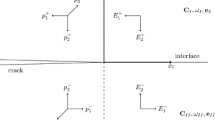Abstract
An electrically impermeable interface crack between two semi-infinite piezoelectric planes under remote mechanical tension-shear and electrical loading is studied. Assuming the stresses, strains and displacements are independent on the coordinate x 2 the expressions for the elastic displacement and potential jumps as well as for the stresses and electrical displacement along the interface via a sectionally holomorphic vector function are found. Introducing an artificial contact zone at the right crack tip and assuming the materials possess the symmetry class 6 mm the problem is reduced for a wide range of bimaterial compounds to a combination of combined Dirichlet–Riemann and Hilbert boundary value problems which are solved analytically. From these solutions clear analytical expressions for characteristic mechanical and electrical parameters are derived. As particular cases of the above mentioned solution the classical (oscillating) and contact zone solutions are obtained. Further, a comparison with an associated solution for an electrically permeable crack has been performed. The fracture mechanical parameters for all models via the remote loads are found analytically and important relationships between these parameters are obtained. Due to these relationships an important algorithm of a numerical method applicable for the investigation of an interface crack in a finite sized piezoelectric bimaterial is suggested.
Similar content being viewed by others
References
Atkinson, C. (1982). The interface crack with contact zone (an analytical treatment). International Journal of Fracture 18, 161–177.
Beom, H.G. and Atluri, S.N. (1996). Near-tip fields and intensity factors for interfacial cracks in dissimilar anisotropic piezoelectric media. International Journal of Fracture 75, 163–183.
Comninou, M. (1977). The interface crack. Journal of Applied Mechanics 44, 631–636.
Dundurs, J. and Gautesen, A.K. (1988). An opportunistic analysis of the interface crack. International Journal of Fracture 36, 151–159.
Dunn, M.L. and Taya, M. (1993). Micromechanics predictions of the effetive electroelastic moduli of piezoelectric composites. International Journal Solids Structures 30, 161–175.
Dunn, M.L. (1994). The effect of crack faces boundary conditions on the fracture mechanics of piezoelectric solids. Engineering Fracture Mechanics 48, 25–39.
Eshelby, J.D., Read, W.T. and Shockley, W. (1953). Anisotropic elasticity with application to dislocation theory. Acta Metallurgica 1, 251–259.
Gao, C.F. and Fan, W.X. (1999). Exact solution for the plane problem in piezoelectric materials with an elliptic hole or a crack. International Journal Solids Structures 36, 2527–2540.
Herrmann, K.P. and Loboda, V.V. (1998). Special approach for the determination of fracture mechanical parameters at an interface crack tip. Archive of Applied Mechanics 68, 227–236.
Herrmann, K.P. and Loboda, V.V. (1999). On interface crack models with contact zones situated in an anisotropic bimaterial. Archive of Applied Mechanics 69, 317–335.
Herrmann, K.P. and Loboda, V.V. (2000). Fracture mechanical assessment of electrically permeable interface cracks in piezoelectric bimaterials by consideration of various contact zone models. Archive of Applied Mechanics 70, 127–143.
Kogan, L., Hui, C.Y., Molkov, V. (1996). Stress and induction field of a spheroidal inclusion or a penny shaped crack in a transversely isotropic piezoelectric material. International Journal Solids Structures 33, 2719–2737.
Kudryavtsev, B.A., Parton, V.Z. and Rakitin, V.I. (1975). Fracture mechanics of piezoelectric materials. Rectilinear tunnel crack in the interface with conductor. Prikladnaya Matematika i Mechanika 39, 149–159 (in Russian).
Kuo, C.M. and Barnett, D.M. (1991). Stress singularities of interface cracks in bonded piezoelectric half-spaces. In Modern Theory of Anisotropic Elasticity and Applications (Edited by J. J. Wu, T. C. T. Ting and D. M. Barnett)., SIAM Proceedings Series, Philadelphia, PA 33–50.
Loboda, V.V. (1993). The quasi-invariant in the theory of interface cracks. Engineering Fracture Mechanics 44, 573–580.
Muskhelishvili, N.I. (1953). Some Basic Problems in the Mathematical Theory of Elasticity. Noordhoff, The Netherlands.
Pak, Y.E. (1992). Linear electro-elastic fracture mechanics of piezoelectric materials. International Journal of Fracture 54, 79–100.
Park, S.B. and Sun, C.T. (1995). Effect of electric field on fracture of piezoelectric ceramics. International Journal of Fracture 70, 203–216.
Parton, V.Z. and Kudryavtsev, B.A. (1988). Electromagnetoelasticity. Gordon and Breach Science Publishers, New York.
Qin, Q.-H. and Mai, Y.-W. (1999). A closed crack model for interface cracks in thermopiezoelectric materials. International Journal Solids Structures 36, 2463–2479.
Sokolnikoff, I.S. (1956). Mathematical Theory of Elasticity. McGraw-Hill, New York.
Sosa, H.A. and Khutoryansky, N. (1996). New developments concerning piezo-electric materials with defects. International Journal Solids Structures 33, 3399–3414.
Suo, Z., Kuo, C.-M., Barnett, D.M. and Willis, J.R. (1992). Fracture mechanics for piezoelectric ceramics. Journal of Mechanics and Physics of Solids 40, 739–765.
Williams, M.L. (1959). The stresses around a fault or cracks in dissimilar media. Bulletin of the Seismological Society of America 49, 199–204.
Zhang, T.Y., Qian, C.F. and Tong, P. (1998). Linear electro-elastic analysis of a cavity or a crack in a piezoelectric material. International Journal Solids Structures 35, 2121–2149.
Author information
Authors and Affiliations
Rights and permissions
About this article
Cite this article
Herrmann, K., Loboda, V. & Govorukha, V. On contact zone models for an electrically impermeable interface crack in a piezoelectric bimaterial. International Journal of Fracture 111, 203–227 (2001). https://doi.org/10.1023/A:1012269616735
Issue Date:
DOI: https://doi.org/10.1023/A:1012269616735



